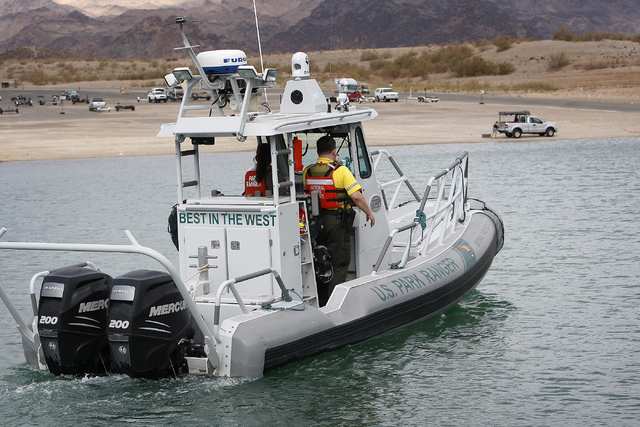Lake Mead’s waters tempting, but dangerous
It was hot, and Jorge Luna wanted to go for a swim.
He had been driving his rental ski boat on the Colorado River the morning of July 20 with family and, after watching them splash and cool off in the water, he wanted to do the same. He hadn’t been in the river all day.
The sun was beating down, so Luna cut the engine and jumped in for a quick dip.
In the seconds that followed, everything seemed calm. His girlfriend of 10 years, Tonja Sweeney, stayed onboard with her daughter, 21, and nephew, 15, who had been swimming earlier. But as the three soaked up the last few moments of their weekend adventure, Sweeney suddenly heard Luna shout, “Help!”
She looked over to see Luna stiff, almost unresponsive, with little more than his head above the water. She processed his cry as their eyes met, and her heart sank.
“When I saw his eyes … His arms and legs were not working,” Sweeney said. “Something was horribly wrong.”
She frantically looked for a life jacket, flipping up all the seats on the unfamiliar boat as her daughter and nephew tried to reach and lift Luna, but his weight pulled them down.
“By the time I got the boat in reverse, by the time I found the flotation device, he was already under,” she said of Luna, who lay on the water that day despite being a strong, able-bodied swimmer. “I had him one minute, and in less than five minutes I didn’t have him.”
Luna was one of three swimmers who went missing earlier this month at the Lake Mead National Recreation Area. The National Park Service uses the busy summer season to remind visitors — even the strongest of swimmers — of the water’s potential dangers.
Park spokeswoman Christie Vanover said nine people have died on the water this year, including those missing and presumed dead. That’s triple the three deaths Lake Mead saw last year, but Vanover said it still falls within the annual average of five to 12.
“Most of them happen in the summer,” Vanover said. “Even though we’re only halfway through the year, visitation on the water is highest in the summer because the water is a lot warmer then.”
And with 6.5 million people passing through each year, Lake Mead is one of the most-visited recreational areas in the nation. Its 247 square miles of blue waters and about 2,400 square miles of canyons and trails beat even Yosemite and Yellowstone in annual visitor numbers. But not everyone knows the area well, and not everyone understands the risks.
“The lake is vast,” Vanover said. “People underestimate its size and the distance from swimming from one point to another.”
The valley also is prone to winds, she said. As winds pick up, they can create waves anywhere from 8 to 10 feet tall or larger.
“When those waves start crashing over you and tossing you from one way to another, it makes it a lot harder to swim,” Vanover said, adding that none of the people who died were wearing life jackets.
“It’s kind of like a seat belt. Are you gonna get into an accident that day? Probably not. But when you jump in, your life jacket is your seat belt, and just in case, it’s there to save your life.”
Sweeney said she understands that wearing a life jacket might have kept Luna afloat, but she said his death was not that simple. Luna was right next to the boat when he froze and fell away from her.
She thinks he went into shock jumping into the cool Black Canyon water, downstream from Hoover Dam. And according to a study published in the Journal of Physiology, that’s possible. The desert temperatures were in the triple digits, and the water Luna plunged into was less than 60 degrees. If his body went into shock and demanded oxygen just as his natural diving response conserved his air supply, the conflict could have caused a heart attack.
Even if his body is recovered, the study notes, the heart’s electrical disturbances are undetectable post-mortem, so deaths under these circumstances are often considered drownings.
As she mourns Luna, Sweeney said she wants to warn others about acclimating themselves to the water before diving in.
Nick Duhe, the Nevada Department of Wildlife boating education coordinator, agreed that the cold water can cause problems. The stretch of the Colorado River where Sweeney swam was significantly colder than Lake Mead itself, which hovers around 80 degrees at the surface during the summer. But he warned lake swimmers about possible cold pockets.
“If you’re going to jump into that water, your muscles might cramp up,” Duhe said. “Even if you’re a strong, hard swimmer, you’re working harder and harder to reach your boat and keep your head above water.”
He reiterated that acclimating yourself to the water and wearing your life jacket are essential to swimming and boating safety.
“People need to be aware of stresses when boating — sun, wind, the smell of gasoline from the motor, maybe alcohol,” Duhe said. “All of that adds to inability to make good judgment on the water.”
If someone jumps or falls into the water, they can be in immediate danger without the proper precautions, he said. Both currents and winds can separate boats from swimmers quickly. And if the driver is in the water, he said, passengers might not know how to operate the boat well — as was the case with Sweeney — which means recovering them from the water can take longer.
“People always think drowning is very violent,” Duhe said. “Drowning is quiet.”
Just like Tonja Sweeney’s last glimpse of Jorge Luna.
“It was just a matter of ‘help,’ ” Sweeney said. “And those eyes … I can’t forget those eyes.”
Contact Rachel Crosby at rcrosby@reviewjournal.com or 702-387-5290. Follow @rachelacrosby on Twitter.
















